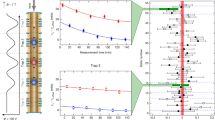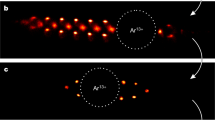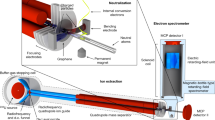Abstract
Optical atomic clocks are the most accurate measurement devices ever constructed and have found many applications in fundamental science and technology1,2,3. The use of highly charged ions (HCI) as a new class of references for highest-accuracy clocks and precision tests of fundamental physics4,5,6,7,8,9,10,11 has long been motivated by their extreme atomic properties and reduced sensitivity to perturbations from external electric and magnetic fields compared with singly charged ions or neutral atoms. Here we present the realization of this new class of clocks, based on an optical magnetic-dipole transition in Ar13+. Its comprehensively evaluated systematic frequency uncertainty of 2.2 × 10−17 is comparable with that of many optical clocks in operation. From clock comparisons, we improve by eight and nine orders of magnitude on the uncertainties for the absolute transition frequency12 and isotope shift (40Ar versus 36Ar) (ref. 13), respectively. These measurements allow us to investigate the largely unexplored quantum electrodynamic (QED) nuclear recoil, presented as part of improved calculations of the isotope shift, which reduce the uncertainty of previous theory14 by a factor of three. This work establishes forbidden optical transitions in HCI as references for cutting-edge optical clocks and future high-sensitivity searches for physics beyond the standard model.
This is a preview of subscription content, access via your institution
Access options
Access Nature and 54 other Nature Portfolio journals
Get Nature+, our best-value online-access subscription
$29.99 / 30 days
cancel any time
Subscribe to this journal
Receive 51 print issues and online access
$199.00 per year
only $3.90 per issue
Buy this article
- Purchase on Springer Link
- Instant access to full article PDF
Prices may be subject to local taxes which are calculated during checkout



Similar content being viewed by others
Data availability
The traces of the frequency ratios are available at https://doi.org/10.5281/zenodo.6901524. Further datasets generated and analysed during this study are available from the corresponding author on request.
Code availability
All code that has been used to generate or analyse data during this study are available from the corresponding author on request.
References
Ludlow, A. D., Boyd, M. M., Ye, J., Peik, E. & Schmidt, P. O. Optical atomic clocks. Rev. Mod. Phys. 87, 637–701 (2015).
Safronova, M. S. et al. Search for new physics with atoms and molecules. Rev. Mod. Phys. 90, 025008 (2018).
Mehlstäubler, T. E., Grosche, G., Lisdat, C., Schmidt, P. O. & Denker, H. Atomic clocks for geodesy. Rep. Prog. Phys. 81, 064401 (2018).
Kozlov, M. G., Safronova, M. S., Crespo López-Urrutia, J. R. & Schmidt, P. O. Highly charged ions: optical clocks and applications in fundamental physics. Rev. Mod. Phys. 90, 045005 (2018).
Schiller, S. Hydrogenlike highly charged ions for tests of the time independence of fundamental constants. Phys. Rev. Lett. 98, 180801 (2007).
Berengut, J., Dzuba, V. & Flambaum, V. Enhanced laboratory sensitivity to variation of the fine-structure constant using highly charged ions. Phys. Rev. Lett. 105, 120801 (2010).
Berengut, J. C., Dzuba, V. A., Flambaum, V. V. & Ong, A. Optical transitions in highly charged californium ions with high sensitivity to variation of the fine-structure constant. Phys. Rev. Lett. 109, 070802 (2012).
Derevianko, A., Dzuba, V. A. & Flambaum, V. V. Highly charged ions as a basis of optical atomic clockwork of exceptional accuracy. Phys. Rev. Lett. 109, 180801 (2012).
Safronova, M. S. et al. Highly charged Ag-like and In-like ions for the development of atomic clocks and the search for α variation. Phys. Rev. A 90, 042513 (2014).
Yudin, V. I., Taichenachev, A. V. & Derevianko, A. Magnetic-dipole transitions in highly charged ions as a basis of ultraprecise optical clocks. Phys. Rev. Lett. 113, 233003 (2014).
Beloy, K., Dzuba, V. A. & Brewer, S. M. Quadruply ionized barium as a candidate for a high-accuracy optical clock. Phys. Rev. Lett. 125, 173002 (2020).
Egl, A. et al. Application of the continuous Stern-Gerlach effect for laser spectroscopy of the 40Ar13+ fine structure in a Penning trap. Phys. Rev. Lett. 123, 123001 (2019).
Soria Orts, R. et al. Exploring relativistic many-body recoil effects in highly charged ions. Phys. Rev. Lett. 97, 103002 (2006).
Zubova, N. A. et al. Isotope shifts of the 2p3/2–2p1/2 transition in B-like ions. Phys. Rev. A 93, 052502 (2016).
Gillaspy, J. D. Highly charged ions. J. Phys. B 34, 93–130 (2001).
Arnold, K. J., Kaewuam, R., Roy, A., Tan, T. R. & Barrett, M. D. Blackbody radiation shift assessment for a lutetium ion clock. Nat. Commun. 9, 1650 (2018).
Hachisu, H. et al. Trapping of neutral mercury atoms and prospects for optical lattice clocks. Phys. Rev. Lett. 100, 53001 (2008).
Bieber, D. J., Margolis, H. S., Oxley, P. K. & Silver, J. D. Studies of magnetic dipole transitions in highly charged argon and barium using an electron beam ion trap. Phys. Scr. T73, 64–66 (1997).
Soria Orts, R. et al. Zeeman splitting and g factor of the 1s22s22p2P3/2 and 2P1/2 levels in Ar13+. Phys. Rev. A 76, 052501 (2007).
Mäckel, V., Klawitter, R., Brenner, G., Crespo López-Urrutia, J. R. & Ullrich, J. Laser spectroscopy on forbidden transitions in trapped highly charged Ar13+ ions. Phys. Rev. Lett. 107, 143002 (2011).
Brewer, S. M. et al. 27Al+ quantum-logic clock with a systematic uncertainty below 10−18. Phys. Rev. Lett. 123, 033201 (2019).
Schmöger, L. et al. Coulomb crystallization of highly charged ions. Science 347, 1233–1236 (2015).
Micke, P. et al. Coherent laser spectroscopy of highly charged ions using quantum logic. Nature 578, 60–65 (2020).
King, S. A. et al. Algorithmic ground-state cooling of weakly coupled oscillators using quantum logic. Phys. Rev. X 11, 041049 (2021).
Lange, R. et al. Improved limits for violations of local position invariance from atomic clock comparisons. Phys. Rev. Lett. 126, 011102 (2021).
Agababaev, V. A. et al. Ground-state g factor of middle-Z boronlike ions. J. Phys. Conf. Ser. 1138, 012003 (2018).
Agababaev, V. A. et al. g factor of the [(1s)2(2s)22p]2P3/2 state of middle-Z boronlike ions. X-Ray Spectrom. 49, 143–148 (2020).
Yu, Y.-m. & Sahoo, B. K. Investigating ground-state fine-structure properties to explore suitability of boronlike S11+–K14+ and galliumlike Nb10+–Ru13+ ions as possible atomic clocks. Phys. Rev. A 99, 022513 (2019). Note: units for quadrupole moment in Table VI should read ×10−7 Hz/(V/m2) (Y.-m. Yu, private communication).
Müller, R. A. Private communication (2021).
Micke, P. et al. The Heidelberg compact electron beam ion traps. Rev. Sci. Instrum 89, 063109 (2018).
Leopold, T. et al. A cryogenic radio-frequency ion trap for quantum logic spectroscopy of highly charged ions. Rev. Sci. Instrum 90, 073201 (2019).
Micke, P. et al. Closed-cycle, low-vibration 4 K cryostat for ion traps and other applications. Rev. Sci. Instrum 90, 065104 (2019).
Schmidt, P. O. et al. Spectroscopy using quantum logic. Science 309, 749–752 (2005).
Matei, D. G. et al. 1.5 μm lasers with sub-10 mHz linewidth. Phys. Rev. Lett. 118, 263202 (2017).
Lapierre, A. et al. Relativistic electron correlation, quantum electrodynamics, and the lifetime of the 1s22s22p 2P o3/2 level in boronlike argon. Phys. Rev. Lett. 95, 183001 (2005).
Peik, E., Schneider, T. & Tamm, C. Laser frequency stabilization to a single ion. J. Phys. B At. Mol. Opt. Phys. 39, 145–158 (2006).
Rosenband, T. et al. Frequency ratio of Al+ and Hg+ single-ion optical clocks; metrology at the 17th decimal place. Science 319, 1808–1812 (2008).
Dubé, P., Madej, A. A., Zhou, Z. & Bernard, J. E. Evaluation of systematic shifts of the 88Sr+ single-ion optical frequency standard at the 10−17 level. Phys. Rev. A 87, 023806 (2013).
Keller, J., Partner, H. L., Burgermeister, T. & Mehlstäubler, T. E. Precise determination of micromotion for trapped-ion optical clocks. J. Appl. Phys. 118, 104501 (2015).
Beloy, K. et al. Frequency ratio measurements at 18-digit accuracy using an optical clock network. Nature 591, 564–569 (2021).
Nemitz, N. et al. Absolute frequency of 87Sr at 1.8 × 10−16 uncertainty by reference to remote primary frequency standards. Metrologia 58, 025006 (2021).
Pizzocaro, M. et al. Absolute frequency measurement of the 1S0–3P0 transition of 171Yb with a link to international atomic time. Metrologia 57, 035007 (2020).
Shabaev, V. M. QED theory of the nuclear recoil effect in atoms. Phys. Rev. A 57, 59–67 (1998).
Arapoglou, I. et al. g-factor of boronlike argon 40Ar13+. Phys. Rev. Lett. 122, 253001 (2019).
Yu, Y.-m & Sahoo, B. K. Selected highly charged ions as prospective candidates for optical clocks with quality factors larger than 1015. Phys. Rev. A 97, 041403 (2018).
Bekker, H. et al. Detection of the 5p–4f orbital crossing and its optical clock transition in Pr9+. Nat. Commun. 10, 5651 (2019).
Berengut, J. C., Delaunay, C., Geddes, A. & Soreq, Y. Generalized King linearity and new physics searches with isotope shifts. Phys. Rev. Res. 2, 043444 (2020).
Rehbehn, N.-H. et al. Sensitivity to new physics of isotope-shift studies using the coronal lines of highly charged calcium ions. Phys. Rev. A 103, 040801 (2021).
Dzuba, V. A. & Flambaum, V. V. Highly charged ions for atomic clocks and search for variation of the fine structure constant. Hyperfine Interact. 236, 79–86 (2015).
Porsev, S. G. et al. Optical clocks based on the Cf15+ and Cf17+ ions. Phys. Rev. A 102, 012802 (2020).
Nazé, C. et al. Isotope shifts in beryllium-, boron-, carbon-, and nitrogen-like ions from relativistic configuration interaction calculations. At. Data Nucl. Data Tables 100, 1197–1249 (2014).
Benkler, E. et al. End-to-end topology for fiber comb based optical frequency transfer at the 10−21 level. Opt. Express 27, 36886–36902 (2019).
Itano, W. M. External-field shifts of the 199Hg+ optical frequency standard. J. Res. Natl Inst. Stand. Technol. 105, 829–837 (2000).
Akerman, N. & Ozeri, R. Atomic combination clocks. New J. Phys. 20, 123026 (2018).
Gan, H. C. J. et al. Oscillating-magnetic-field effects in high-precision metrology. Phys. Rev. A 98, 032514 (2018).
Arnold, K. J. et al. Precision measurements of the 138Ba+6s2S1/2–5d2D5/2 clock transition. Phys. Rev. Lett. 124, 193001 (2020).
Yerokhin, V. A., Müller, R. A., Surzhykov, A., Micke, P. & Schmidt, P. O. Nonlinear isotope-shift effects in Be-like, B-like, and C-like argon. Phys. Rev. A 101, 012502 (2020).
Shabaev, V. M., Tupitsyn, I. I. & Yerokhin, V. A. Model operator approach to the Lamb shift calculations in relativistic many-electron atoms. Phys. Rev. A 88, 012513 (2013).
Shabaev, V. M., Tupitsyn, I. I. & Yerokhin, V. A. QEDMOD: Fortran program for calculating the model Lamb-shift operator. Comput. Phys. Commun. 189, 175–181 (2015).
Yerokhin, V. A. Nuclear-size correction to the Lamb shift of one-electron atoms. Phys. Rev. A 83, 012507 (2011).
Angeli, I. & Marinova, K. P. Table of experimental nuclear ground state charge radii: an update. At. Data Nucl. Data Tables 99, 69–95 (2013).
Wang, M. et al. The Ame2012 atomic mass evaluation. Chin. Phys. C 36, 1603–2014 (2012).
Acknowledgements
We thank L. Schmöger, M. Schwarz and J. Stark for early contributions to the experimental apparatus, T. Legero for his contributions to the frequency stabilization of the HCI spectroscopy laser, H. Margolis for discussions about the analysis of the frequency data and F. Wolf for comments on the manuscript. A.S. and V.A.Y. thank I. I. Tupitsyn for discussions. The project was supported by the Physikalisch-Technische Bundesanstalt, the Max Planck Society, the Max Planck-Riken-PTB Center for Time, Constants and Fundamental Symmetries, and the Deutsche Forschungsgemeinschaft (DFG, German Research Foundation) through SCHM2678/5-1, SU 658/4-2, the collaborative research centres SFB 1225 ISOQUANT and SFB 1227 DQ-mat, and under Germany’s Excellence Strategy – EXC-2123 QuantumFrontiers – 390837967. These projects 17FUN07 CC4C and 20FUN01 TSCAC have received funding from the EMPIR programme co-financed by the participating states and from the European Union’s Horizon 2020 research and innovation programme. This project has received funding from the European Research Council (ERC) under the European Union’s Horizon 2020 research and innovation programme (grant agreement no. 101019987). S.A.K. acknowledges financial support from the Alexander von Humboldt Foundation.
Author information
Authors and Affiliations
Contributions
S.A.K., L.J.S., P.M., T.L., E.B., J.R.C.L.-U. and P.O.S. developed the experimental setup. S.A.K., L.J.S., P.M., A.W., R.L. and N.H. carried out the experiments. S.A.K., L.J.S., A.W. and E.B. analysed the data. J.R.C.L.-U. and P.O.S. conceived and supervised the study. A.S. and V.A.Y. performed the theoretical calculations. S.A.K., L.J.S., A.S. and P.O.S. wrote the initial manuscript, with contributions from P.M. and J.R.C.L.-U. All authors discussed the results and reviewed the manuscript.
Corresponding authors
Ethics declarations
Competing interests
The authors declare no competing interests.
Peer review
Peer review information
Nature thanks Victor Flambaum, Bijaya Kumar Sahoo and the other, anonymous, reviewer(s) for their contribution to the peer review of this work. Peer reviewer reports are available.
Additional information
Publisher’s note Springer Nature remains neutral with regard to jurisdictional claims in published maps and institutional affiliations.
Extended data figures and tables
Supplementary information
Rights and permissions
Springer Nature or its licensor (e.g. a society or other partner) holds exclusive rights to this article under a publishing agreement with the author(s) or other rightsholder(s); author self-archiving of the accepted manuscript version of this article is solely governed by the terms of such publishing agreement and applicable law.
About this article
Cite this article
King, S.A., Spieß, L.J., Micke, P. et al. An optical atomic clock based on a highly charged ion. Nature 611, 43–47 (2022). https://doi.org/10.1038/s41586-022-05245-4
Received:
Accepted:
Published:
Issue Date:
DOI: https://doi.org/10.1038/s41586-022-05245-4
This article is cited by
-
Development and commissioning of the UNIST electron beam ion trap
Journal of the Korean Physical Society (2024)
-
Testing quantum electrodynamics in extreme fields using helium-like uranium
Nature (2024)
-
Hyperfine-structure-resolved laser spectroscopy of many-electron highly charged ions
Communications Physics (2023)
Comments
By submitting a comment you agree to abide by our Terms and Community Guidelines. If you find something abusive or that does not comply with our terms or guidelines please flag it as inappropriate.



